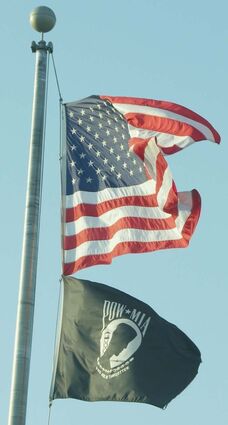The wind does blow
April 21, 2022
Though the sky was overcast and the temperature on the cool side when Christians gathered outside Sunday morning for their traditional Easter sunrise services, many expressed thanks the strong winds of recent weeks were missing.
Strong winds are a normal characteristic of winter and spring in the Great Plains and the National Weather Service considered April to be the windiest month of the year. So this year's breezy conditions should not be a surprise to Midlands residents. But those who believe it has been extra windy this year are right. The National Weather Service reports it has been.
The weather service reports this has been the windiest April since 1999. Grand Island wind records date to 1948 and for the first 17 days of April, the average daily wind speed at Grand Island is about 1.75 miles above average.
According to a story published Monday by the Omaha World-Herald, eastern Nebraska is averaging its second-windiest year to date and the second windiest spring to date since 1960.
In terms of ridiculously windy days, Taylor Nicolaisen, a National Weather Service meteorologist, said some Nebraska locations have set records for the number of days with wind gusts in excess of 40 miles per hour.
Unlike the temperature and precipitation records which have been kept at millions of sites for decades, there is a lack of calibrated, consistent wind speed measurements which makes it difficult to understand wind patterns and trends. Accurate wind sensors haven't been around as long as thermometers and rain gauges and wind is a highly localized, variable phenomenon.
A study published in 2019 and an earlier one published in 2011 indicate winds speeds have been increasing in recent years.
This year's high winds and drought have brought localized dust storms and caused some people to imagine what it was like to live in these parts when dust storms were more common.
In the spring of 1934 the Nelson Gazette published the following story written by Ida Alberding:
Mother and I and sister, Rachel, came to Nelson in the fall of 1901; my brother, Henry, followed later. I was working in the country the spring of 1902. I had never seen a dust storm so didn't know what to think (when I experienced my first). I actually thought the world was coming to an end.
It seemed to me like it was still where I stood, but the wind blew in a circle around me. The sky looked a kind of grayest pink.
I asked the lady I was working for what it was and she just laughed at me and said it was only a dust storm.
I was wondering what kind of a country we had gotten into, never having seen anything like that in Iowa where we came from.
My maiden name was Ida Galusha.
On March 21, 1935, the Superior Weekly Journal headlined the paper's lead story with "Worst Dust Storm in History Here, Old Timers cannot recall any storm which equals one last Friday."
It was nearly a week later and Superior businessmen and housewives were still energetically attempting to get rid of the dust which resulted from a dust storm which struck the town on Friday evening.
Coming behind a gale which reached a high velocity, large clouds of fine dust raced through the air in what old time residents of Superior claimed the worst dust storm they ever saw. (They were to see worse as the drought intensified) This was undoubtedly saying considerable for several old timers professed to have seen some bad storms.

Although a strong wind with accumulating dust made things disagreeable for local residents during the day, the storm did not reach its full intensity until around nine o'clock in the evening.
Pedestrians were forced to seek shelter soon after the storm struck for to have remained in it for any length of time would surely have resulted yield a fatal outcome. Motorists were force to drive at a snail's pace because of being more than half blinded by the dust and took much longer to reach their destinations than they ordinarily would have. In many instances the drivers lost their bearings and being more than half stifled by the dust, sought shelter until the storm abated somewhat. In a later storm the paper was to report many automobile engines were ruined by the dust.
Electric lights were out during the worst part of the storm but fortunately did not remain out for any great length of time.
The storm slacked up about midnight and a light snow fell which freshened the atmosphere somewhat.
The Lincoln Journal reported great clouds of black dust, were racing eastward across Nebraska and Kansas behind a gale which reached a velocity of 63 miles per hour at Sidney.
In mid-afternoon, the sun at Sidney was obscured and residents of that section sought shelter from the choking atmosphere.
The storm came upon the heels of balmy, spring like weather, in which temperatures in the 80s were not uncommon, A few hours before the storm hit the temperature had reached 84 degrees in Lincoln which was a record for the first half of March.

Wind, wind and more wind. According to the National Weather Bureau, this spring has been the windest spring on record since 1960.
After one of the April 1935 storms, C. J. Dahlgren, who lived a half-mile west of Superior, swept the dirt from his 6 foot by14 foot porch. He weighed the dirt at 28 pounds and thought it a record. After another storm four days later, he swept the porch again and cleaned off 145 pounds of dirt. Fences on the Dahlgren place, along the cement plant road, were nearly covered with dust drifts. Roadside ditches were level full and in many places the drifts extended entirely across the road and were 18 inches deep.







Reader Comments(0)